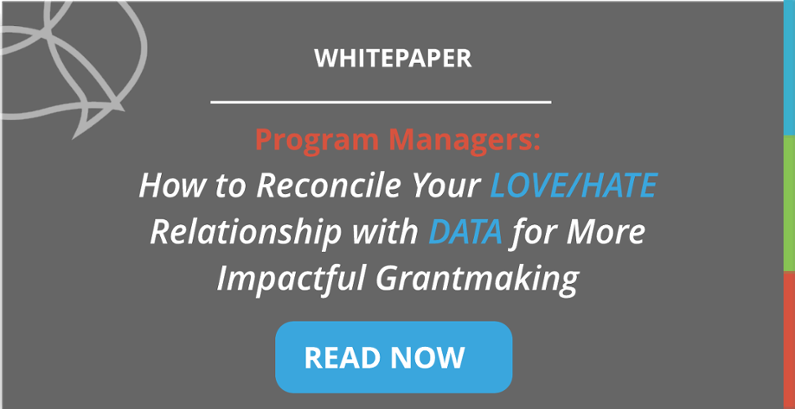 As a program manager and subject expert, you’ve always believed in the importance of capturing information and stories that articulate the impact of your work. Until recently, however, you may not have had the time, resources, or expertise to take your data practices to the next level.
As a program manager and subject expert, you’ve always believed in the importance of capturing information and stories that articulate the impact of your work. Until recently, however, you may not have had the time, resources, or expertise to take your data practices to the next level.
Philanthropy’s growing emphasis on data-driven decision making may have even provoked a love/hate relationship with number crunching. That love/hate feeling isn’t unfounded. If too strict, funding strategies based on data-driven models can threaten your autonomy and expertise. What’s more, relying solely on these models can unfairly “punish” grantees who are trying innovative approaches that might not deliver “the right metrics” in the short term.
It’s important to remember though, "Data should be used to support decision-making, provide a basis for relationship-building, and shine a light on your program area, not replace your expertise,” says Brad Cameron-Cooper, Communications & Knowledge Management Associate at the Winthrop Rockefeller Foundation. "Data should be used as a flashlight, not a hammer.”
Mastering data allows you to see patterns and deficiencies across teams and grant portfolios, provide grantees with more nuanced insight, and share lessons learned with other foundation staff. Data not only helps you see the bigger picture, but it also helps you understand what that picture is telling you.
Use Data As a Flashlight, Not a Hammer
While some program staff fear their decisions will be reduced to a set of data points and the story behind the numbers will be lost, data actually provides multiple opportunities to better understand and improve your programs.
Here are four ways you can leverage your data to improve your programs :
- Develop a more effective framework to ensure grantee success.
When foundations ask grantees to provide narrative descriptions of their programs, goals, and projected outcomes, they make assumptions about the kinds of data worth collecting and analyzing. “Help grantees understand what these individual data points are from the very beginning of the grant cycle, so they know which outcomes your foundation wishes to support over time,” says David Goodman, Director of Impact at Fluxx.
Whether your foundation’s framework for reporting is prescriptive or open-ended, articulate data points that help both staff and grantees align more closely with your foundation’s strategic goals. Have you identified the right outcomes and indicators? Is your framework or strategy accurate and appropriate for the specific geographic setting or individual program?
Understanding this data ultimately allows program staff to be more effective in their position, refine programs and strategies, and use lessons learned to inform the success of individual grantees.
- Collaborate across and between your foundation’s departments.
When assessment and evaluation data is siloed within your organization, information about data and metrics are seldom shared and colleagues are unable to leverage or learn from them until the final report is submitted, if at all. But when everyone on your staff has access to the same data, and in real time, collaborations across and between foundation departments can make for stronger programmatic frameworks or highly targeted RFPs that lead to more appropriate funding strategies.
Staff collaboration and engagement can also save valuable time and resources by reducing redundancies. Use reporting data to work more closely with grants managers on key administrative tasks, for example. Are you asking the kinds of questions on proposals and RFPs that will help grantees identify and measure valuable data?
The lessons you learn from working with your grant portfolio can – and should – have an impact on staff throughout the foundation. “You may find it necessary to ask more specific questions on your proposals, or that a particular programmatic strategy is successful but not scalable. By making these insights available to all staff in real time, data becomes more transparent and collaboration across foundation departments becomes part of your new, data-driven culture,” says Goodman.
- Build the capacity of your team and your grantees.
With the right technology in place, data helps you translate your foundation’s programmatic strategy into opportunities for expanded and sustained impact, while also building stronger relationships with your grantees.
What kinds of measurable change does your foundation value? Which data points – from geography to populations served – can give you a better collective picture of your grantees?
Use big-picture observations like these as a jumping-off point for understanding what your grantees are doing at the program level and for helping them to build capacity. What issues or challenges do your grantees face in conducting their funded work? How can data help you support or fine-tune these strategies? And what did you learn about your own processes that can be improved upon?
As you know, individual relationships with grantees are deeply reciprocal and offer opportunities to learn more about your field. What knowledge and lessons do your grantees share that can help you make sense of the data you’re seeing? Taken together, program data and deep, contextual relationships can help you build the capacity of individual grantees across your portfolio, allowing you to make connections and identify strategies for success.
- Share insights with your staff, grantees, and the broader philanthropic community.
We don’t learn individually or as a sector unless we’re able to translate lessons across teams, geography, program areas, and even foundations. Without access to real-time data, it becomes impossible to discuss what’s happening in individual programs – or to see how each of these programs can improve strategically.
For example, visualizations of historic data in your grant portfolio should inform foundation-wide conversations about funding strategies, building grantee capacity, and data collection, more generally. While each program area – or grant type – might require different kinds of data, lessons learned from an individual grant portfolio may have bearing on the work happening in others.
The challenge is real. But if you understand the benefits and see a path forward, they become easier to address and overcome. “Simply put, data allows you to discuss challenge areas, what’s working or not working in funding strategies, and lessons learned as a foundation,” Goodman concludes. And as opportunities for you to share knowledge increase throughout the philanthropic sector, data will help move funders forward and make a broader, more sustained impact.